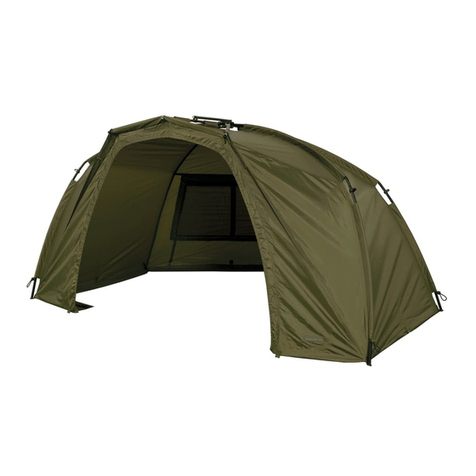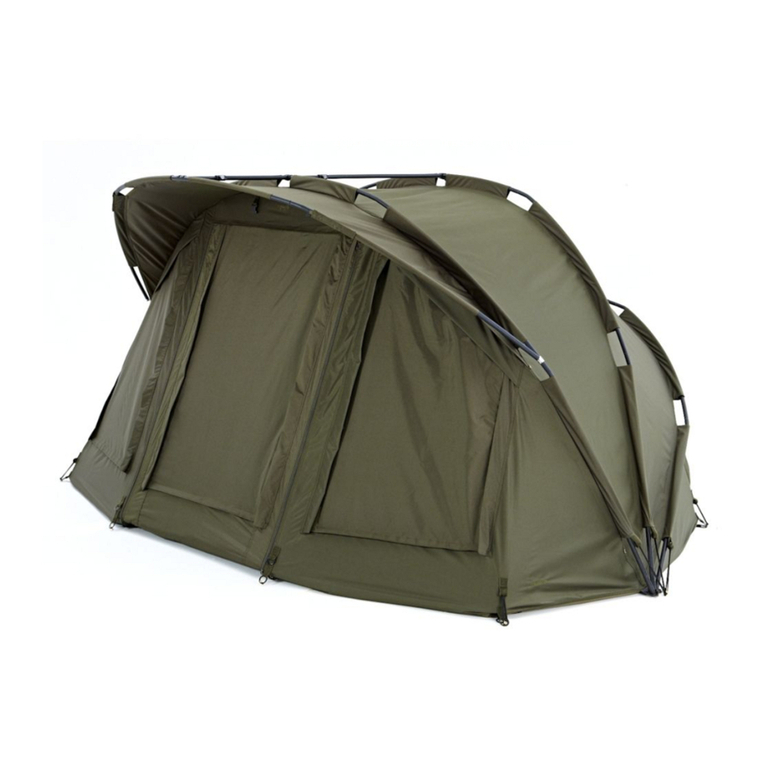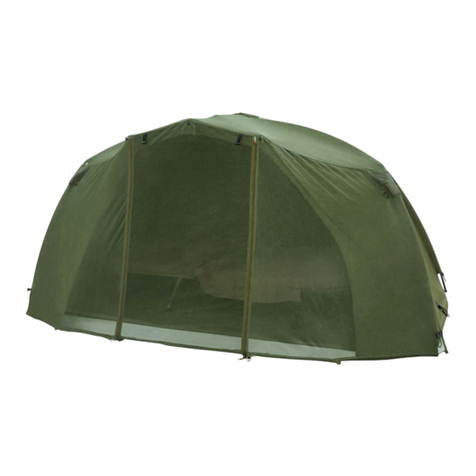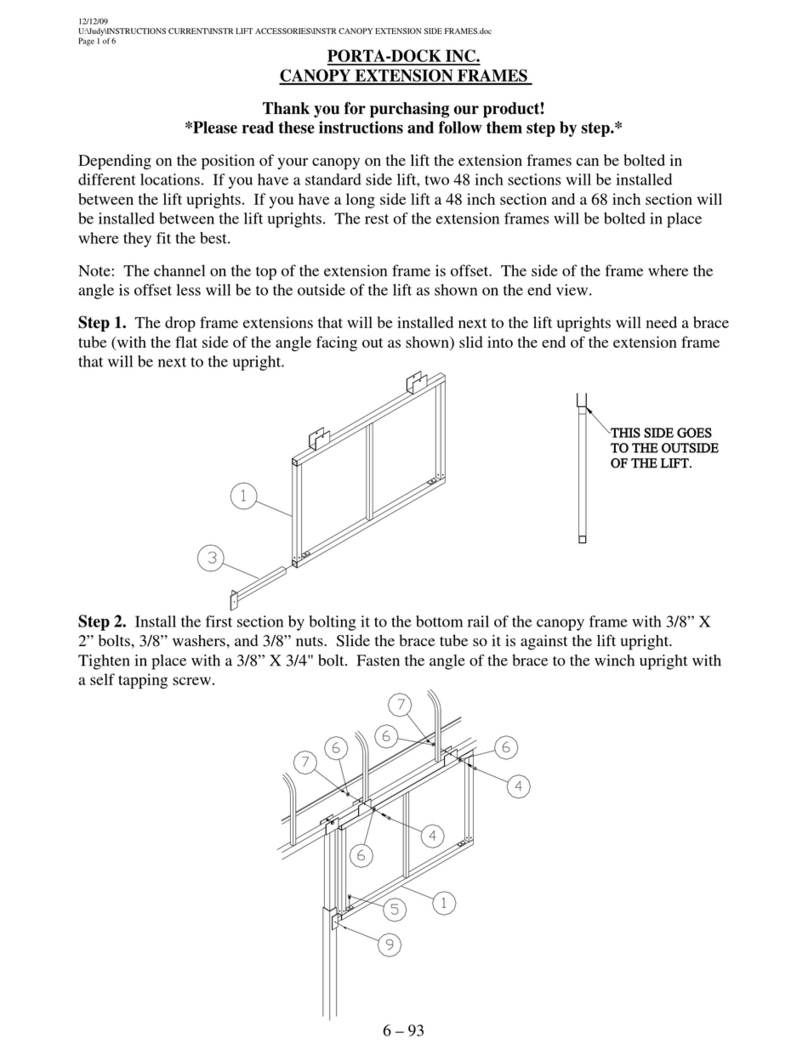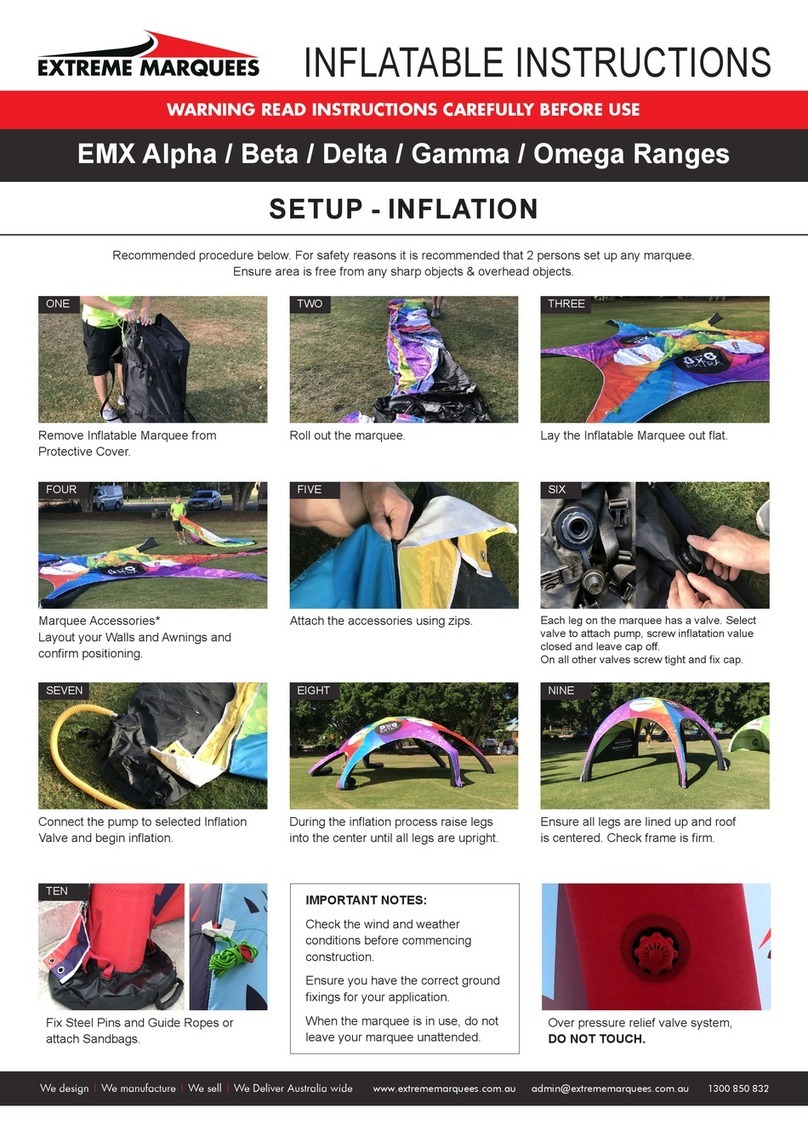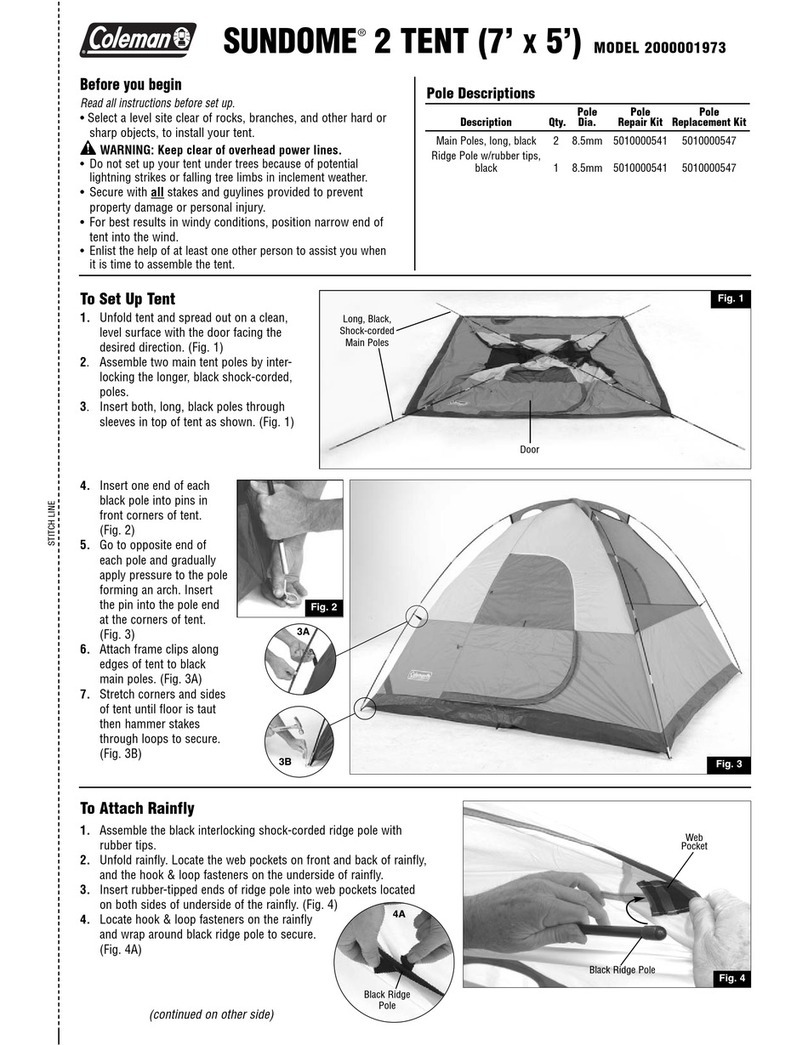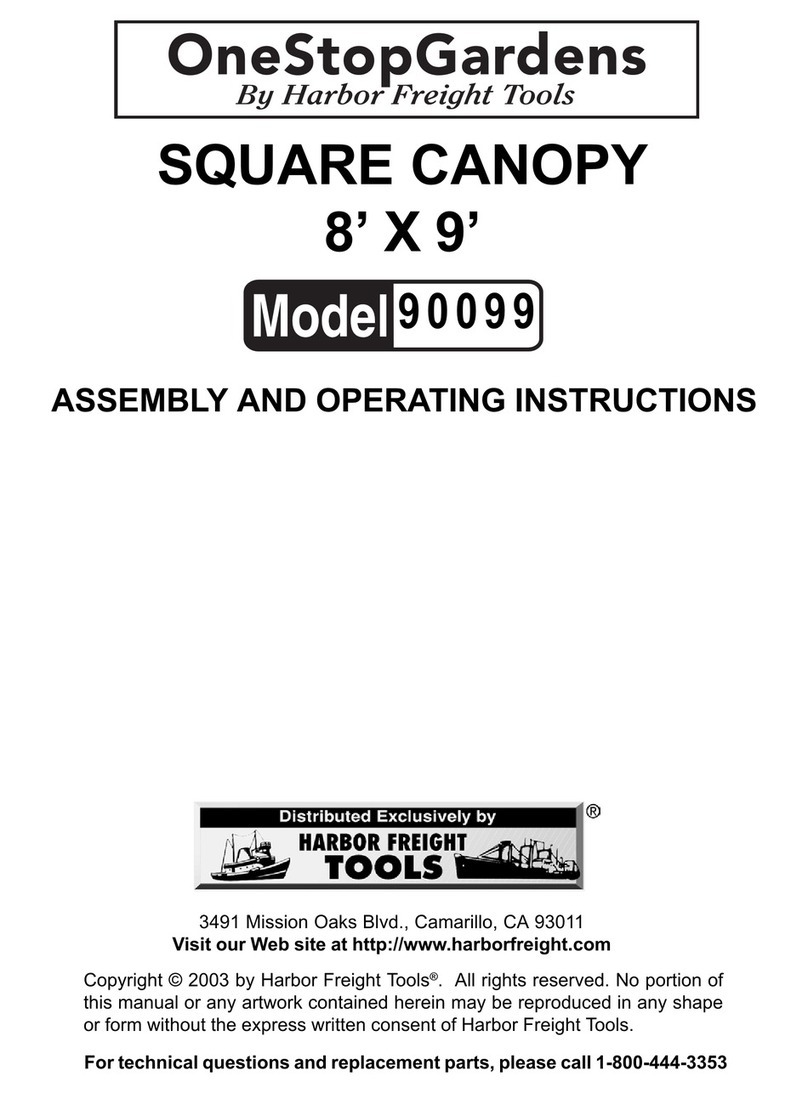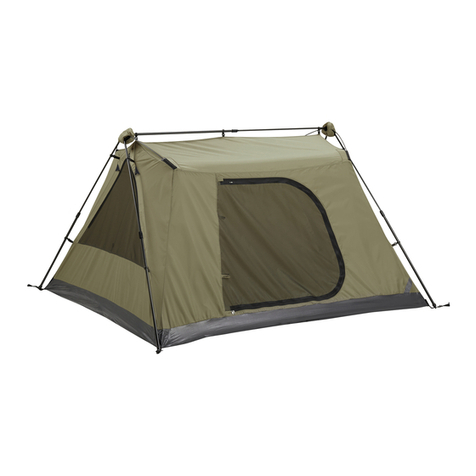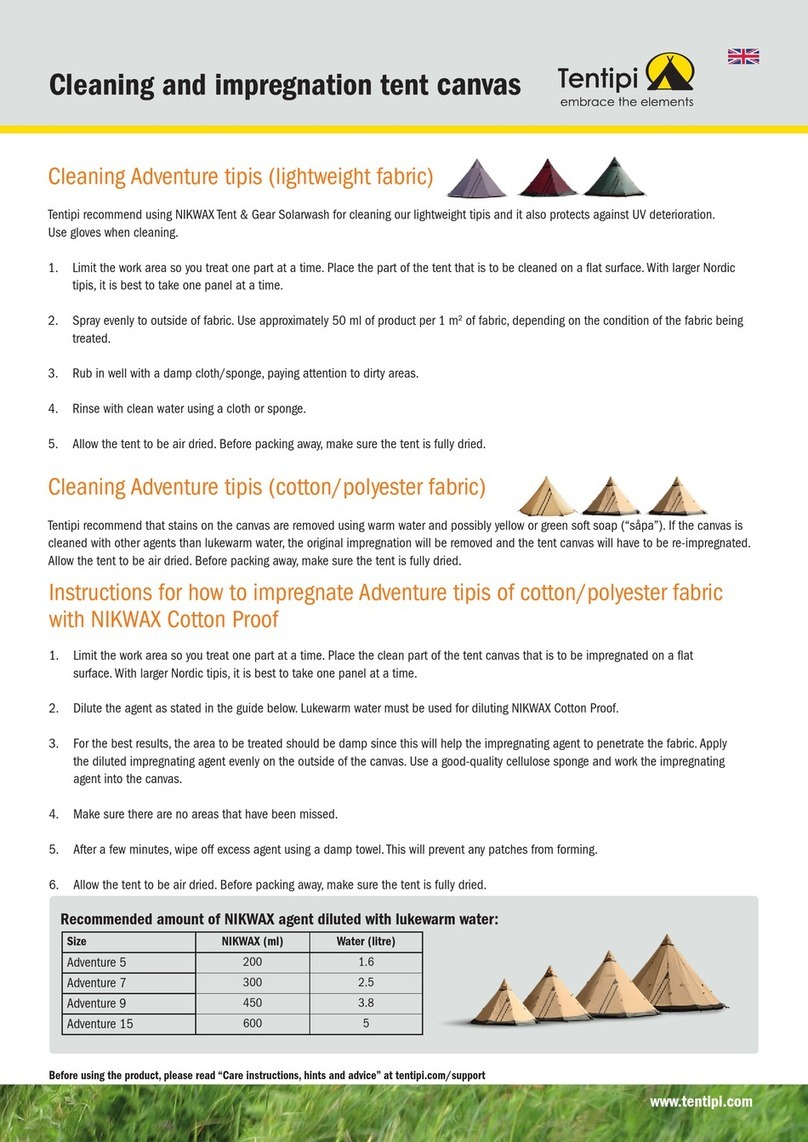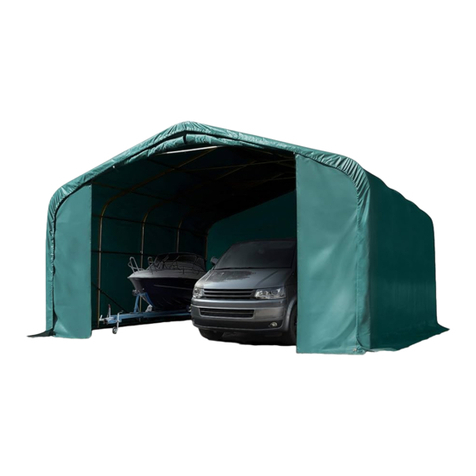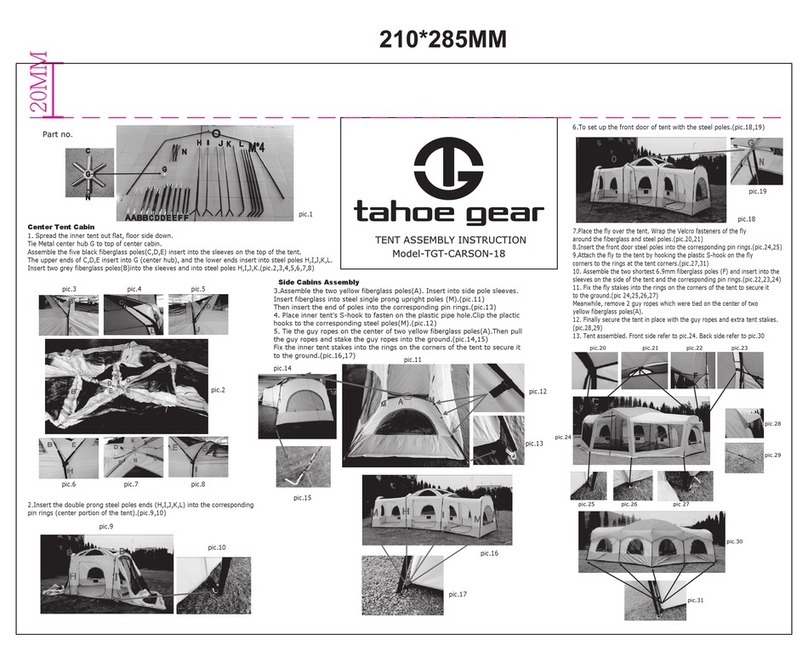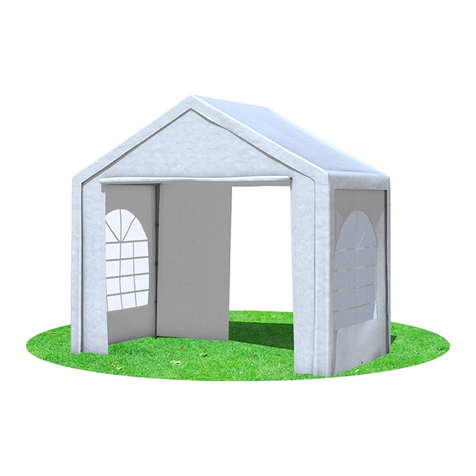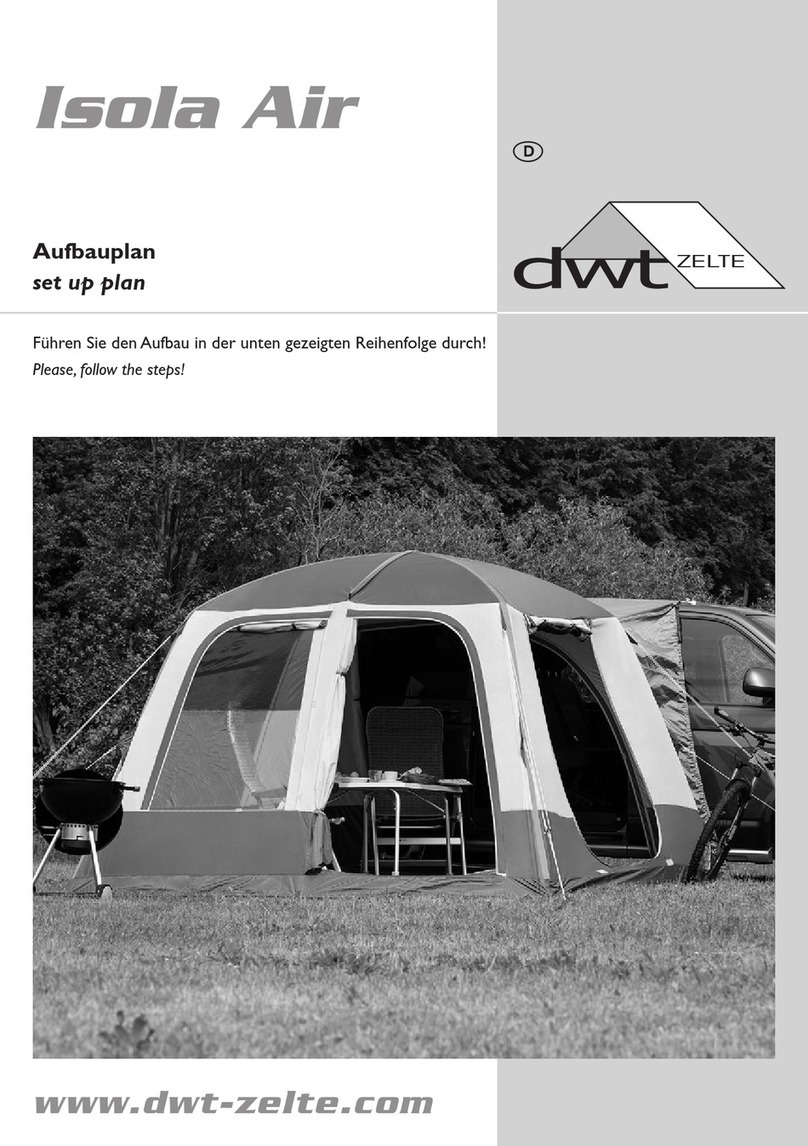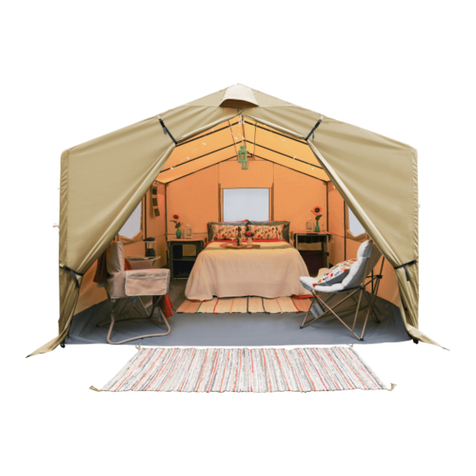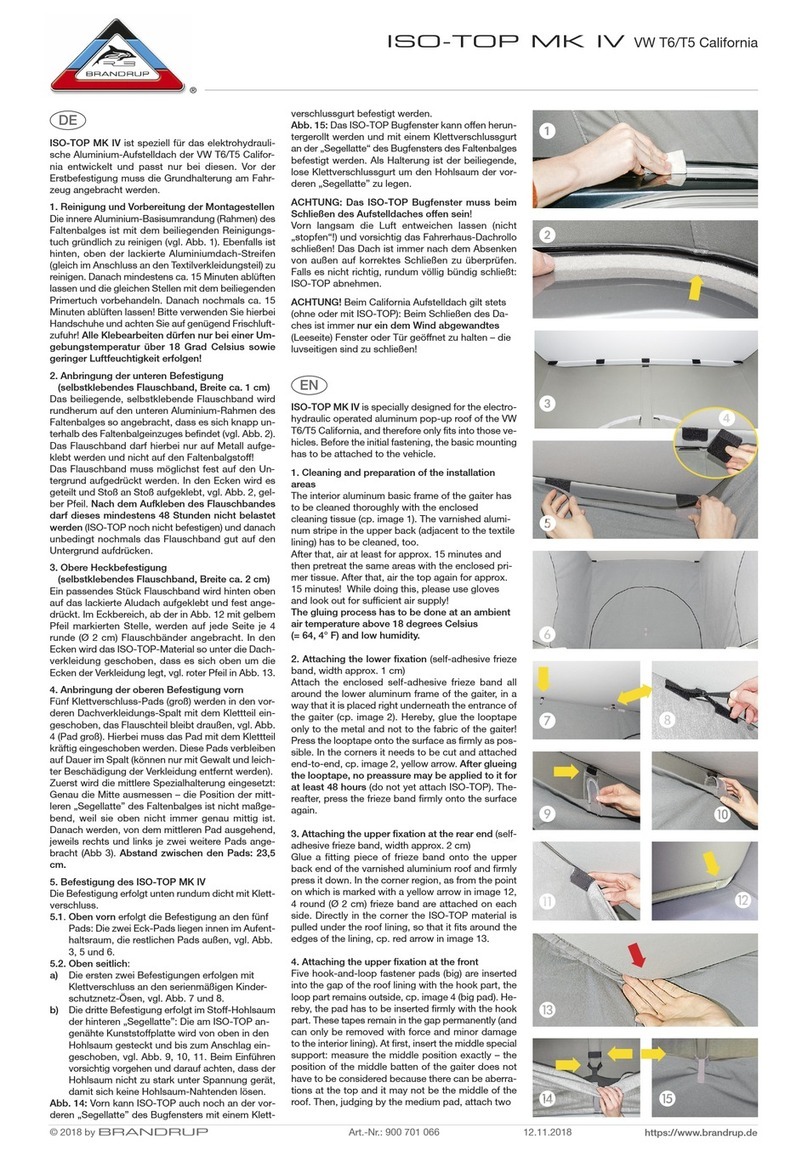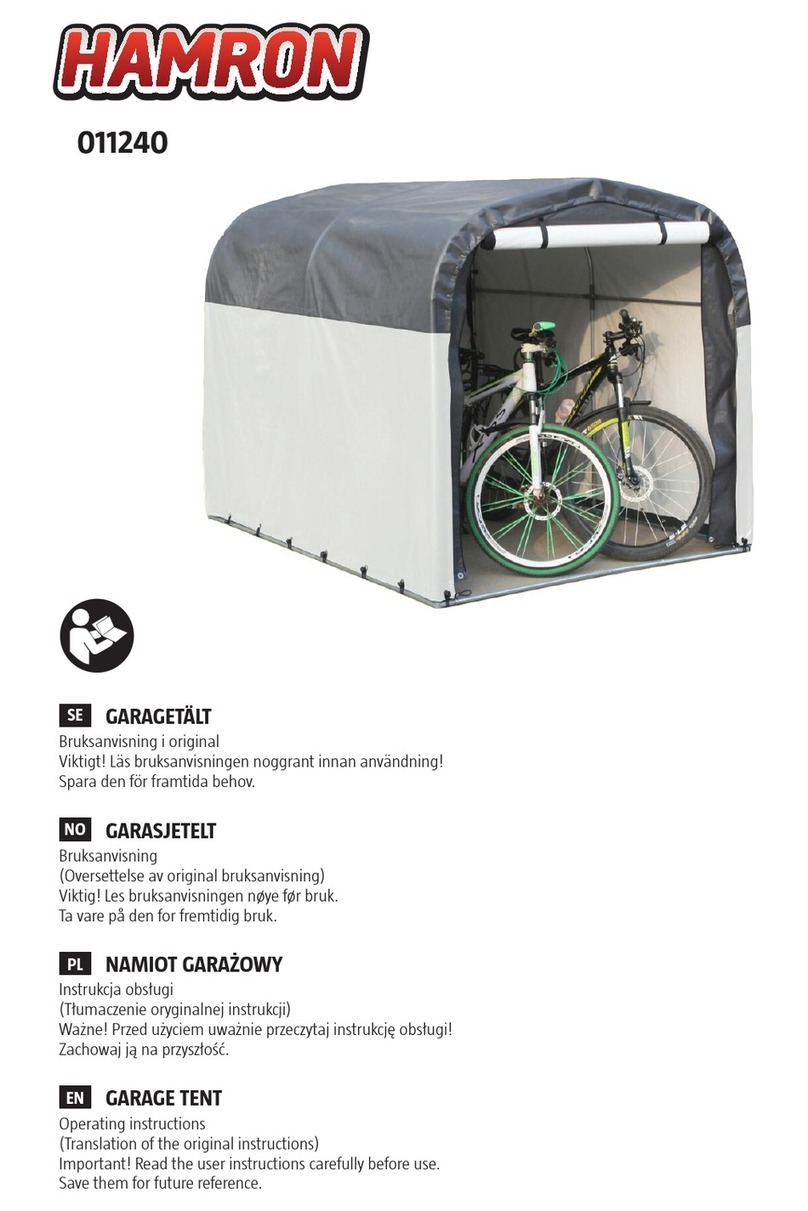Trakker COMPOSITE V2 User manual

Please read carefully before using this product
TEMPEST SET UP
ASSEMBLY INSTRUCTIONS
COMPOSITE V2
201620 TEMPEST XL
201558
TEMPEST V2
201553

1. Open the groundsheet in your chosen location with the
small Trakker label indicating the door position and
the elasticated pegging points located underneath the
groundsheet. Loosely install a couple of pegs to hold it
in position.
2. Lay the bivvy on to the groundsheet and carefully open
it out. Once the bivvy is fully opened out, insert the five
elasticated pole sections together. Check that they are
inserted properly.
3 Standing in the doorway of the groundsheet, position
the junction block in the middle of your chest. Hold
the two outermost poles attached to the rear part of
the block and pull the poles round towards you as wide
as possible, so as to tension the fabric. If you find it
difficult to spread the poles, stop and check that the
fabric is not tangled around the pole ends. Do not
force it.
4. Now reach over and pull the handle that is attached to
the rear half of the centre junction block all the way
over. Pull up the middle front pole and squeeze the
two together until they touch. Slide the locking ring
over the end of the handle and release the tension to
lock it in place. You must ensure that the panels are
not tangled during this process, as it may damage the
frame when opening. If you meet resistance, stop and
check to see what the problem is.
5. Attach the tension rings on the inside of the first
left and right poles to the tensioning hooks on the
groundsheet. If you are using the bivvy without a
groundsheet, then please use the tension strap
provided.
6. Peg down the rear bivvy poles using the lower pegging
point on the bivvy and the corresponding groundsheet
rings.
7. Peg the rest of the bivvy down using the groundsheet
as a rough guide. The door determines the position of
the front pegging points, so ensure it is closed during
this process and slightly slack when pegged so that
the zips run freely. Then extend the storm rods to
tension the material.
8. Put the Quickstick storm poles into the sleeves at the
front of the bivvy and screw them onto the storm caps.
Quicksticks are supplied with quick fit adapters and
can be removed, simply by releasing the top thumb
screw and unplugging from the adapter leaving it on
the storm cap, you can use these to add extra support
to the front of the bivvy.
9. The internal draft skirts should now be tucked under
the groundsheet to prevent moisture from entering the
bivvy.
ASSEMBLY 1 3
4 5
6 7
8
TEMPEST SET UP
1. To disassemble the bivvy, firstly remove the pegs (do
not pull on the material to remove pegs, pull the pegs
themselves) then remove storm rods and unclip the
bivvy from the groundsheet/tension strap.
2. Squeeze the handles together to release the tension
on the ring and slide the ring towards you, allowing the
handles to come apart.
3. Carefully allow the bivvy to fold and lay it on to the
groundsheet. Once the bivvy is in this position, you
can disassemble the poles and fold the bivvy in half,
ensuring no material is wrapped over the ends of
the poles during folding as the fabric could become
damaged.
4. Lay open the carry bag on the groundsheet and place
the bivvy in junction block first. When zipping up the
carry bag, make sure not to trap any fabric in the zip.
DISASSEMBLY
2
9
COMPOSITE V2
201620
TEMPEST V2
201553
TEMPEST XL
201558

WARRANTY INFORMATION
For more information on products
and a full list of retailers, checkout
www.trakkerproducts.com
Trakker Products Ltd Unit C5,
Nunnery Drive Parkway Industrial Estate
Sheffield, S2 1TA
Tel: +44 (0)1142 727 783
Fax: +44 (0)1142 725 904
Email: [email protected]
TEMPEST SET UP
STORAGE
Storage is one of the most important aspects of bivvy care.
Your bivvy should be packed away dry. If packed away wet,
it should be dried within 24-hours of returning from your
session. If the bivvy is left wet, mildew will form, which can
severely damage the material and tape seals. It is worth
checking your bivvy frequently for signs of wear and tear,
which may require attention.
Remember: Store your bivvy in a cool dry place away from
sources of heat. The carry bag should be left unzipped if
stored for extended periods. Reproof with Fabsil Gold at
least once annually. Cleaning and reproofing your bivvy
will strengthen the fabric and improve its ability to repel
water.
CLEANING
– Do not use detergents to clean as they may harm the
proofing.
– Never machine wash or tumble dry.
– Avoid contact with abrasive scrubbing agents/cloths.
– Avoid contact with fuel, oil and chemicals.
Your warranty does not cover contact with the
aforementioned agents/chemicals.
WARRANTY
All Trakker shelters and wraps are covered by a 12-Month
Manufacturer Warranty supplied as standard. The
warranty runs from the date of purchase and covers
replacement at our expense and discretion (with the
same or similar model from our current range) or repair
including parts and labour in the event of a manufacturing
fault appearing with your shelter. Your warranty cover
excludes faults arising from misuse, incorrect or negligent
repairs or “Acts of God”. Fabric damaged caused by
mildew, incorrect washing or improper storage is not
covered by the Trakker warranty.
This guarantee is only valid when used for recreational
purposes, not including commercial usage i.e. hiring, use
by outdoor centres etc. Please ensure that all products are
clean and dry prior to being returned.
No consequential loss may be claimed
under this guarantee.
Your warranty is provided in addition to
any statutory rights.
COMPOSITE V2
201620
TEMPEST V2
201553
TEMPEST XL
201558

1. Ouvrez le tapis de sol dans l’emplacement choisi avec
la petite étiquette Trakker qui indique la position de la
porte et les points de rattachement élastiqués situés
au-dessous du tapis de sol. Attachez lâchement deux
sardines pour le tenir en position.
2. Mettez le bivvy sur le tapis de sol et ouvrez-le avec
soin. Lorsque le bivvy est complètement ouvert,
insérez les cinq mâts élastiqués ensemble. Vérifiez
s’ils sont insérés correctement.
3. En tenant debout dans l’entrée du tapis de sol,
positionnez le bloc de jonction au milieu de votre
poitrine. Tenez les deux mâts le plus externes qui sont
attachés à l’arrière du bloc et déployez les mâts le
plus étendus que possible, afin de mettre la toile sous
tension. Si c’est difficile de déployer les mâts, arrêtez
et vérifiez si la toile n’est pas emmêlée autour du bout
des mâts. Ne la forcez pas.
4. Maintenant, tirez la poignée qui est attachée à la
moitié arrière du bloc de jonction central tout le
chemin. Remontez le mât central à l’avant et serrez
les deux jusqu’à ce qu’ils touchent. Faites glisser la
bague en acier inoxydable sur le bout de la poignée
et relâchez la tension pour la verrouiller en place.
Assurez-vous que les panneaux ne sont pas emmêlés
pendant le processus car cela pourrait endommager
le châssis quand vous l’ouvrez. S’il y a un problème,
arrêtez et vérifiez le problème.
5. Attachez les bagues de tension à l’intérieur des
premiers mâts à gauche et à droite aux crochets de
tension sur le tapis de sol. Si vous utilisez le bivvy sans
un tapis de sol, utilisez la sangle de tension qui est
fournie.
6. Fixez les mâts à l’arrière du bivvy en utilisant la bague
inférieure en aluminium sur le bivvy et les bagues
correspondantes du tapis de sol.
7. Fixez le reste du bivvy en utilisant le tapis de sol
comme un guide approximatif. La porte détermine la
position des points de rattachement à l’avant, donc
assurez-vous que c’est fermé pendant ce processus
et un peu lâche quand c’est fixé par terre afin que
les fermetures éclairs se déplacent librement. Puis
étendez les mâts tempêtes pour tendre la toile.
8. Mettez les mâts tempêtes Quickstick dans les
manches à l’avant du bivvy et vissez-les dans les
casquettes tempête. Les Quicksticks sont fournis
avec des adapteurs à ajustement rapide et on peut les
enlever tout simplement en relâchant la vis molette
et en les séparant de l’adapteur et le laissant dans le
casquettes tempête.
9. Vous devriez border les bandes de toile contre
les courants d’air au-dessus du tapis de sol pour
empêcher l’humidité d’entrer dans le bivvy.
MONTAGE
1. Pour démonter le bivvy, premièrement enlevez les
sardines (ne tirez pas la toile mais tirez les sardines)
puis enlevez les mâts tempêtes et relâchez le bivvy du
tapis de sol/sangle de tension.
2. Serrez les poignées pour relâcher la tension sur
la bague et faites glisser la bague vers vous, en
permettant aux poignées de se démonter.
3. Pliez le bivvy avec soin et mettez-le sur le tapis de
sol. Lorsque le bivvy est en position, vous pouvez
démonter les mâts et plier en deux le bivvy, en
assurant que aucune partie de la toile est emmêlée
sur les bouts des mâts pendant le démontage car cela
pourrait l’endommager.
4. Laissez ouvert le sac de rangement sur le tapis de
sol et mettez le bivvy là-dedans, le bloc de jonction
d’abord. Quand vous fermez le sac de rangement à
fermeture éclair, assurez-vous de ne pas attraper la
toile dans la fermeture éclair.
DÉMONTAGE
TEMPEST SET UP COMPOSITE V2
201620
TEMPEST V2
201553
TEMPEST XL
201558
1 3
4 5
6 7
8
2
9

RANGEMENT
Le rangement est un des aspects le plus important du soin
du bivvy. Avant d’emballer votre bivvy, il devrait être sec.
Si vous emballez un bivvy mouillé, il faut le sécher dans
les vingt-quatre heures. Sinon, la moisissure se forme
qui peut endommager gravement la toile et les rubans
adhésifs. Il faut examiner fréquemment votre bivvy pour
les signes d’usure, qui peuvent avoir besoin d’être réparés.
ATTENTION : Rangez votre bivvy dans un endroit frais et
sec loin des sources de chaleur. Il faut laisser ouvert le sac
de transport au moyen de la fermeture éclair si le bivvy est
stocké pendant des périodes étendues. Réimperméabilisez
avec Fabsil Gold au moins une fois par an. Nettoyer et
réimperméabiliser le bivvy rendra la toile plus forte et plus
capable de repousser l’eau.
NETTOYAGE
– N’utilisez pas les détergents car ils pourraient
endommager l’imperméabilisation.
– Ne jamais laver à la machine ni sécher par culbutage.
– Évitez le contact avec les agents de nettoyage et
chiffons abrasifs.
– Évitez le contact avec les combustibles, l’huile et les
produits chimiques.
Votre garantie ne couvre pas le contact avec les agents et
produits chimiques susmentionnés.
LA GARANTIE
Tous les abris et couvertures Trakker sont couverts par
une garantie du constructeur de douze mois en standard.
La garantie commence dès la date d’achat et couvre le
remplacement du produit à nos frais et à notre discrétion
(avec le même produit ou produit semblable de notre
gamme actuelle) ou réparation y compris les pièces et
main d’œuvre en cas de défaut de fabrication avec votre
abri. Votre garantie exclue les défauts créés par l’usage
impropre, des réparations incorrectes et négligentes ou
cas de « force majeure ». Les dégâts à la toile créés par la
moisissure, le lavage incorrect ou le stockage incorrect ne
sont pas couverts par la garantie Trakker.La garantie est
seulement valable quand le produit est utilisé pour des fins
récréatives pas pour l’utilisation commerciale, par exemple
location, utilisation par des centres de plein air. Veuillez-
vous assurer que tous les produits sont propres et secs
avant d’être retournés. Aucune perte indirecte ne peut être
réclamée en vertu de cette garantie. Votre garantie est
fournie en plus de tous les droits statutaires.
INFORMATIONS DE GARANTIE
Pour plus d’informations sur les produits
et une liste complète des détaillants, visitez:
www.trakkerproducts.com
Trakker Products Ltd Unit C5,
Nunnery Drive Parkway Industrial Estate
Sheffield, S2 1TA
Tel: +44 (0)1142 727 783
Fax: +44 (0)1142 725 904
Email: [email protected]
TEMPEST SET UP COMPOSITE V2
201620
TEMPEST V2
201553
TEMPEST XL
201558

1. Öffnen Sie den Zeltboden an der gewünschten Stelle
mit dem kleinen Trakker-Etikett, das die Türposition
und die elastischen Verankerungspunkte unter dem
Zeltboden anzeigt. Verwenden Sie ein paar Heringe,
um es in Position zu halten.
2. Legen Sie das Zelt auf die Zeltplane und öffnen Sie es
vorsichtig. Ist das Bivvy einmal völlig geöffnet, setzen
Sie die fünf elastischen Stangenabschnitte zusammen.
Überprüfen Sie, ob sie richtig eingesetzt sind.
3. Stellen Sie sich in die Türöffnung des Zeltes und
drücken sie den Block in der Mitte der Brust. Halten
Sie die beiden äußersten Stangen fest und fächern
Sie die Stangen so breit wie möglich auseinander um
den Stoff zu spannen. Wenn es Ihnen schwerfällt,
die Stangen zu verteilen, halten Sie an. Vergewissern
Sie sich, dass sich der Stoff nicht um die Stangen
verwickelt hat.
4. Greifen Sie nun über den Griff, der an der hinteren
Hälfte des Mitte Kreuzung Block ganz vorbei. Ziehen
Sie die mittlere vordere Stange hoch und drücke die
beiden zusammen, bis sie sich berühren. Schieben Sie
den Edelstahl Ring über das Ende des Griffs und lösen
Sie die Spannung, um sie zu arretieren. Sie müssen
sicherstellen, dass sich die Panels während dieses
Prozesses nicht verwickeln, da kann den Rahmen beim
Öffnen beschädigen. Wenn Sie Widerstand treffen,
stoppen Sie und überprüfen Sie um zu sehen, was das
Problem ist.
5. Befestigen Sie die Spannringe an der Innenseite des
Zeltbodens an den Haken. Wenn Sie das Bivvy ohne
Boden verwenden, Befestigen sie den Spanngurt.
6. Befestigen Sie die hinteren Bivvy Stange mit
dem unteren Aluminiumring am Bivvy und die
entsprechenden Bodenplane Ringe.
7. Die Tür bestimmt die Position der vorderen
Befestigungspunkte, also stellen Sie sicher,
dasswährend dieses Vorgangs geschlossen und locker
ist, so dass die Reißverschlüsse frei laufen können.
Dann verlängern Sie die Quicksticks, um das Material
zu spannen.
8. Setzen Sie die Quickstick Sturmstangen in die
Ärmel an der Vorderseite des Zeltes und schrauben
sie sie auf das Tempest. Quicksticks werden mit
Schnellverschlussadapter geliefert und können
entfernt werden, indem Sie einfach die obere
Rändelschraube lösen und Trennen vom Adapter, um
es auf dem Bivvy zu lassen.
9. Die Innenzugröcke sollten jetzt unter der Bodenplane
verstaut werden, um zu verhindern, dass Feuchtigkeit
in das Zelt eindringt.
VERSAMMLUNG
1. Um das Bivvy zu zerlegen, entfernen Sie zuerst die
Heringe (ziehen Sie nicht am Material zum Entfernen
von Heringe, ziehen Sie die Heringe selbst) dann
entfernen Sie die Quicksticks und entriegeln Sie das
Zelt von der Zeltplane / Spanngurt.
2. Drücken Sie die Griffe zusammen, um die Spannung
zu lösen, und schieben Sie den Ring in Ihre Richtung,
sodass die Griffe auseinanderfallen können.
3. Lassen Sie das Bivvy vorsichtig zusammenfalten und
legen Sie es auf den Zeltboden. Sobald das Bivvy in
dieser Position ist, können Sie die Stangen zerlegen
und das Bivvy in der Mitte falten, sicherstellend,
dass kein Material über die Enden der Stangen dabei
eingewickelt wird, da der Stoff beschädigt werden
könnte.
4. Legen Sie die Tragetasche auf dem Zeltboden auf und
legen Sie das Zelt mit dem Verbindungsblock zuerst in
die Tasche. Wenn Sie die Tragetasche zippen, stellen
Sie sicher, dass Sie kein Material einklemmen.
DEMONTAGE
TEMPEST SET UP COMPOSITE V2
201620
TEMPEST V2
201553
TEMPEST XL
201558
1 3
4 5
6 7
8
2
9

LAGERUNG
Die Lagerung ist einer der wichtigsten Aspekte der
Bivvypflege. Ihr Bivvy sollte trocken verpackt werden.
Wenn es nass verpackt ist, sollte es innerhalb von 24
Stunden nach der Session getrocknet werden. Wenn
das Bivvy nass bleibt, bildet sich Schimmel, der das
Material und die Klebebanddichtungen stark beschädigen
kann. Es lohnt sich, Ihr Bivvy häufig auf Anzeichen von
Abnutzung zu überprüfen. Denke daran: Lagern dein Zelt
an einem kühlen, trockenen Ort, fern von Hitzequellen. Die
Tragetasche sollte bei längerer Lagerung entpackt bleiben.
Versiegelung mit Fabsil Gold mindestens einmal jährlich.
Das Reinigen und Nachbessern deines Bivvy wird das
Gewebe stärken und seine Fähigkeit verbessern, Wasser
abzuweisen.
REINIGUNG
– Verwende keine Reinigungsmittel zum Reinigen, da
diese die Versiegelung beschädigen können.
– Niemals in der Maschine waschen oder im Trockner
trocknen.
– Vermeide den Kontakt mit Scheuermitteln / -tüchern.
– Vermeide den Kontakt mit Kraftstoff, Öl und
Chemikalien.
Die Garantie erlischt bei Verwendung von diesen Mitteln.
GARANTIE
Alle Trakker Zelte und Wraps sind durch eine 12-monatige
Herstellergarantie abgedeckt, die als Standard geliefert
wird. Die Garantie läuft ab dem Kaufdatum und umfasst
den Ersatz auf unsere Kosten und Diskretion (mit dem
gleichen oder einem ähnlichen Modell aus unserem
aktuellen Sortiment) oder Reparatur einschließlich Teile
und Arbeit im Falle eines Herstellungsfehlers, der bei Ihrem
Bivvy auftritt. Ihre Garantieabdeckung schließt Mängel
aus Missbrauch, fehlerhafter oder nachlässiger Reparatur
oder “höherer Gewalt” aus.Unsachgemäßes Waschen oder
unsachgemäße Lagerung verursachte Beschädigungen
sind nicht durch die Trakker-Garantie gedeckt. Diese
Garantie ist nur gültig, wenn sie zu Erholungszwecken
verwendet wird, ausgenommen kommerzielle Nutzung, d.
H. Mieten, Verwendung durch Outdoor-Zentren usw. Bitte
stellen Sie sicher, dass alle Produkte sauber und trocken
sind, bevor sie zurückgegeben werden. Im Rahmen dieser
Garantie dürfen keine Folgeschäden geltend gemacht
werden. Ihre Garantie wird zusätzlich zu allen gesetzlichen
Rechten gewährt.
GARANTIEINFORMATIONEN
Weitere Informationen zu Produkten und eine
vollständige Liste der Einzelhändler finden Sie
unter: www.trakkerproducts.com
Trakker Products Ltd Unit C5,
Nunnery Drive Parkway Industrial Estate
Sheffield, S2 1TA
Tel: +44 (0)1142 727 783
Fax: +44 (0)1142 725 904
Email: [email protected]
TEMPEST SET UP COMPOSITE V2
201620
TEMPEST V2
201553
TEMPEST XL
201558

1. Aprite il pavimento dove desiderate posizionare il
vostro bivvy, con la piccola etichetta Trakker a indicare
la posizione della porta e i punti di picchettaggio
posizionati sulla superficie inferiore del pavimento.
Potete installare due picchetti per mantenerlo in
posizione.
2. Stendete il bivvy sul pavimento e apritelo cautamente.
Una volta che il bivvy sarà aperto completamente,
inserite le cinque sezioni elasticizzate dei pali
una dento l’altra. Controllate che siano inserite
correttamente.
3. State in piedi davanti alla parte della porta del
pavimento e posizionate il blocco centrale del bivvy
sul vostro petto. Afferrate i due pali esterni attaccati
alla parte posteriore del blocco centrale e allargateli il
più possibile, in modo da tensionare il telo. Se trovate
difficoltosa questa operazione, fermatevi e controllate
che il telo non sia arrotolato attorno alle estremità dei
pali. Non forzate.
4. Ora cercate la leva che è attaccata alla metà posteriore
del blocco centrale, e tiratela in avanti. Spingete
in alto il paletto centrale sulla parte frontale del
blocco e premeteli assieme fino a farli toccare. Fate
scorrere l’anello di blocco sull’estremità della leva
e rilasciate la tensione per bloccarlo in posizione.
Dovrete assicurarvi che il pannello frontale non sia
attaccato durante questo processo, poichè potrebbe
danneggiarsi il telaio durante l’apertura. Se incontrate
resistenza eccessiva, fermatevi e controllate per
vedere quale sia il problema.
5. Attaccate gli anelli di tensionamento alle estremità di
entrambi i pali frontali destro e sinistro ai ganci sul
pavimento. Se state usando il bivvy senza tappeto
allora usate cortsememnte la cinghia di tensionamento
fornita.
6. Picchettate al suolo i pali posteriori del bivvy usando
l’anelo di alluminio più basso e in corrisponmdenza con
gli anelli elasticizzati del pavimento.
7. Picchettare il resto del bivvy utilizzando il pavimento
come guida. LA porta determina la posizione dei punti
di picchettaggio frontali, quindi assicuratevi che
sia chiusa durante questo processo e leggermente
allentata quando si picchetta in modo che le zip
scorrano libere. Estendere successivamente gli storm
rods per tensionare il telo.
8. Mettere i Quicksticks Storm Poles all’interno delle
guide in tessuto sul frontale del bivvy e avvitarli sugli
storm caps. I Quicksticks sono forniti con adattatori
a sgancio rapido che possono essere rimossi
semplicememte allentando la vite in alto lasciandoli
sull’estremità degli storm caps.
9. L’eccedenza interna di telo può essere risvoltata al di
sotto del pavimento in modo da evitare che l’umidità
entri da sotto al bivvy.
ASSEMBLAGGIO
1. Per disassemblare il bivvy, rimuovere prima i picchetti
(non tirate i picchetti dal telo, ma prendete i picchetti
stessi e tirate) e poi rimuovete gli storm rods per poi
sganciare le clip di tensionamento dal pavimento/
tension strap.
2. Premere entrambe le leve frontali per rilasciare
la tensione sull’anello di blocco, e farlo scorrere
all’indietro verso di voi, permettendo alle leve di
separarsi.
3. Permettere gentilmente al bivvy di ripiegarsi e
adagiarsi sul pavimento. Una volta che il bivvy sarà
in questa posizione, potrete disassemblare i pali e
ripiegare il bivvy a metà, assicurandovi non ci adel telo
arrotolato attorno alle estremità dei pali durante la
piegatura poichè potrebbe danneggiarsi.
4. Stendere aperta la sacca di trasporto sul tappeto
e piazzare il bivvy al suo interno partendo daal
blocco entrale. Quando richiudete la zip della borsa
assicuratevi di non incastrare del telo nella zip.
DISASSEMBLAGGIO
TEMPEST SET UP COMPOSITE V2
201620
TEMPEST V2
201553
TEMPEST XL
201558
1 3
4 5
6 7
8
2
9

CONSERVAZIONE
La conservazione è uno degli aspetti fondamentali per la
cura del bivvy. Il vostro bivvy dovrebbe essere rigovernato
da asciutto. Se lo richiudete ancora bagnato o umido,
dovrebbe essere poi fatto asciugare all’aria per almeno
24 ore dopo la vostra sessione. Se il bivvy viene lasciato
umido, potrebbe formarsi della muffa che danneggerebbe
seriamente i materiali e le cuciture nastrate. Vale la
pena controllare frequentemente il proprio bivvy per
verificare che non ci siano segni di usura o rottura che
potrebbe necessitare di attenzione. Ricorda: conserva il
tuo bivvy in un luogo fresco e asciutto lontano da fonti di
calore. La borsa di trasporto deve essere lasciata aperta
se lo si tiene conservato lì dentro per lunghi periodi.
Reimpermeabilizzalo con il Fabsil Gold almeno una volta
all’anno. Pulire e reimpermeabilizzare il telo lo aiuta a
rinforzarsi e migliora la sua capacità di repellere l’acqua.
PULIZIA
– Non utilizzare detergenti per pulire il telo poiché essi
potrebbero danneggiarlo.
– Mai usare la lavatrice o l’asciugatrice.
– Evitare il contatto con superfici o tessuti abrasivi.
– Evitare il contatto con carburante, oli e agenti chimici.
La vostra garanzia non copre danni dovuti ad agenti
chimici.
GARANZIA
Tutti i teli e le tende Trakker sono coperte da una garanzia
del costruttore di 12 mesi fornita come da standard. La
garanzia parte dalla data di acquisto e copre sostituzioni
a nostre spese e discrezione (con lo stesso o il più simile
modello della nostra gamma corrente) o riparazioni incluse
parti e manodopera in caso di difetti di fabbricazione
sulla vostra tenda. La copertura della vostra garanzia
non include difetti derivanti da errato utilizzo, errate o
negligenti riparazioni o calamità naturali. I teli danneggiati
da muffa, lavaggi errati o conservazione inappropriata
non sono coperti da garanzia Trakker. Questa garanzia è
valida esclusivamente quando il prodotto è utilizzato per
scopi ricreativi, non includendo utilizzi commerciali come
noleggi, centri esterni ecc. Per cortesia assicurarsi che
i prodotti siano ben puliti e asciutti prima di essere fatti
ritirare. Nessun danno conseguente può essere richiesto
sotto questa garanzia. La vostra garanzia è fornita in
aggiunta a qualsiasi diritto legale.
INFORMAZIONI DI GARANZIA
Per maggiori informazioni sui prodotti a la lista
completa dei nostri rivenditori visitate il sito:
www.trakkerproducts.com
Trakker Products Ltd Unit C5,
Nunnery Drive Parkway Industrial Estate
Sheffield, S2 1TA
Tel: +44 (0)1142 727 783
Fax: +44 (0)1142 725 904
Email: [email protected]
TEMPEST SET UP COMPOSITE V2
201620
TEMPEST V2
201553
TEMPEST XL
201558

1. Jeśli korzystasz z podłogi, umieść ją tam, gdzie chcesz,
aby Twój namiot się znajdował, haczykami na spodzie i
logo z przodu. Luźno wbij kilka szpilek, aby utrzymać ją
w odpowiedniej pozycji.
2. Połóż bivvy na podłodze i ostrożnie go otwórz.
Następnie połącz wszystkie pięć żeber połączonych
ze sobą elastyczną gumą. Bądź pewien, iż są one
poprawnie włożone.
3. Stojąc, umieść głowicę na środku klatki piersiowej.
Przytrzymaj dwa skrajne pałąki przymocowane do tylnej
części bloku i rozwiń drążki tak szeroko, jak to możliwe,
aby napiąć tkaninę. Jeśli sprawia Ci to trudność aby
rozłożyć poprzeczki, zatrzymaj się i sprawdź, czy
tkanina nie jest splątana wokół końców poprzeczek. Nie
rób tego na siłę.
4. Teraz sięgnij i pociągnij za uchwyt, który jest
przymocowany do tylnej połowy środkowego bloku
głowicy. Wyciągnij środkową przednią poprzeczkę i
ściśnij oba razem, aż się zetkną. Przesuń pierścień
blokujący na koniec uchwytu i zwolnij napięcie, aby
zablokować je na swoim miejscu. Musisz upewnić
się, że panele nie są zaplątane podczas tego procesu,
ponieważ może to spowodować uszkodzenie ramy
podczas otwierania. Jeśli napotkasz opór, zatrzymaj się
i sprawdź, na czym polega problem.
5. Przymocuj pierścienie naprężające wewnątrz
lewego i prawego drążka do haków mocujących na
podłodze - jeśli używasz bivvy bez podłogi, użyj paska
napinającego.
6. Teraz przymocuj tylne szpilki za pomocą dolnego
pierścienia na bivvy i odpowiedniego pierścienia
podłogi, a następnie wbij szpilki przednich punktów
mocowania.
7. Wbij resztę szpilek względem krawędzi podłogi. Drzwi
określają położenie przednich punktów mocowania,
więc upewnij się, że są zamknięte w trakcie tego
procesu i lekko luźne, gdy są mocowane, tak aby zamki
przesuwały się swobodnie. Następnie wydłuż sztyce,
aby naprężyć materiał.
8. Włóż sztyce typu Quickstick w rękawy z przodu
namiotu i wkręć je w górne gwinty. Quicksticks są
dostarczane ze specjalną nasadką, którą można
pozostawić na miejscu, a sztycę zwolnić odkręcając jej
górną śrubę mocowania.
9. Aby zapobiec przedostawaniu się wilgoci do wnętrza,
wewnętrzne dolne kurtynki powinny być schowane pod
podłogą.
MONTAŻ
1. Aby zdemontować bivvy, najpierw usuń szpilki (nie
ciągnij za materiał, aby wyjąć szpilki, pociągaj tylko
za szpilki), a następnie odepnij bivvy z podłogi / paska
naprężającego.
2. Ściśnij uchwyty, aby zwolnić naprężenie na pierścieniu
blokującym i przesuń pierścień na zewnętrzną stronę,
umożliwiając rozsunięcie się uchwytów.
3. Ostrożnie pozwól, aby namiot złożył się, następnie
połóż go na podłodze. Gdy biwak znajduje się w tej
pozycji, możesz rozmontować pałąki i złożyć je na
pół, pamiętaj aby podczas składania materiał nie był
przytrzaśnięty żadnym ramieniem, ponieważ tkanina
mogłaby ulec uszkodzeniu.
4. Połóż torbę na podłodze i umieść namiot w jej środku
zaczynając od strony z głowicą najpierw. Zapinając
torbę, upewnij się, że nie przytnie ona żadnej tkaniny w
suwaku.
DEMONTAŻ
TEMPEST SET UP COMPOSITE V2
201620
TEMPEST V2
201553
TEMPEST XL
201558
1 3
4 5
6 7
8
2
9

Trakker Products Ltd Unit C5,
Nunnery Drive Parkway Industrial Estate
Sheffield, S2 1TA
Tel: +44 (0)1142 727 783
Fax: +44 (0)1142 725 904
Email: [email protected]
INFORMACJE NA TEMAT GWARANCJI
TEMPEST SET UP
Przechowywanie
Przechowywanie jest jednym z najważniejszych aspektów
utrzymania brolly w najlepszej kondycji. Twoje bivvy
powinno być suche. Jeśli zostanie zapakowany na mokro,
należy go wysuszyć w ciągu 24 godzin od powrotu z nad
wody. Jeśli bivvy pozostanie mokre, powstanie pleśń, która
może poważnie uszkodzić materiał i uszczelnienia taśmowe.
Warto często sprawdzać swoją brolly w poszukiwaniu
oznak zużycia, które mogą wymagać uwagi. Pamiętaj:
przechowuj biwak w suchym i chłodnym miejscu, z dala
od źródeł ciepła. Torbę należy pozostawić otwartą, jeśli
schronienie przechowywane będzie przez dłuższy czas.
Impregnuj z Fabsil Gold co najmniej raz w roku. Czyszczenie
i impregnowanie twojego bivvy wzmocni tkaninę i poprawi
jej zdolność odpychania wody.
Czyszczenie
– Nie używaj detergentów do czyszczenia, ponieważ mogą
one uszkodzić materiał.
– Nigdy nie prać w pralce ani nie suszyć w suszarce.Unikać
kontaktu ze środkami ściernymi.
– Unikaj kontaktu z paliwem, olejem i chemikaliami.
Gwarancja nie obejmuje kontaktu z wyżej wymienionymi
detergentami / chemikaliami.
Gwarancja
Wszelkie namioty i narzuty marki Trakker objęte są
12-miesięczną gwarancją producenta dostarczaną w
standardzie. Gwarancja rozpoczyna się od daty zakupu
i obejmuje wymianę na nasz koszt i dyskrecję (z tym
samym lub podobnym modelem z naszego aktualnego
asortymentu) lub naprawę obejmującą części i robociznę
w przypadku błędu produkcyjnego występującego w twoim
namiocie. Gwarancja nie obejmuje błędów wynikających
z niewłaściwego użycia, nieprawidłowych lub niedbałych
napraw lub “sił wyższych”. Tkanina uszkodzona przez pleśń,
nieprawidłowe mycie lub niewłaściwe przechowywanie nie
jest objęta gwarancją Trakker’a. Ta gwarancja jest ważna
tylko wtedy, gdy jest używana do celów rekreacyjnych, nie
obejmuje użytku komercyjnego, tj. Wynajmu, użycia przez
centra outdoorowe itp. Przed zwrotem należy upewnić się,
że wszystkie produkty są czyste i suche.
W ramach tej gwarancji nie można dochodzić
odszkodowania za straty wynikłe z tego tytułu. Twoja
gwarancja dostarczona jest dodatkowo do twych
ustawowych praw.
Aby uzyskać więcej informacji o produktach i pełnej
liście sprzedawców detalicznych, wejdź na naszą
stronę: www.trakkerproducts.com
COMPOSITE V2
201620
TEMPEST V2
201553
TEMPEST XL
201558

TEMPEST SET UP COMPOSITE V2
201620
TEMPEST V2
201553
TEMPEST XL
201558

TRAKKER PRODUCTS LTD UNIT C5, NUNNERY DRIVE PARKWAY INDUSTRIAL ESTATE SHEFFIELD, S2 1TA
TRAKKERPRODUCTS.COM
TEL: +44 (0)1142 727 783 | FAX: +44 (0)1142 725 904 INFO | @TRAKKERPRODUCTS.COM
TEMPEST
SET UP
COMPOSITE V2
201620
TEMPEST V2
201553
TEMPEST XL
201558
This manual suits for next models
5
Table of contents
Languages:
Other Trakker Tent manuals
